Jake Gyllenhaal & Mark Gordon Source Code
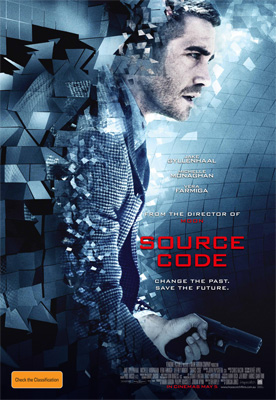
Source Code
Cast: Jake Gyllenhaal, Michelle Monaghan, Vera Farmiga, Jeffrey WrightDirector: Duncan Jones
Genre: Drama, Mystery, Sci-Fi, Thriller
Running Time: 93 Minutes
Synopsis: A helicopter pilot recruited for a top-secret military operation finds himself on a startlingly different kind of mission in Source Code, a smart, fast-paced action thriller that challenges our assumptions about time and space. Filled with mind-boggling twists and heart-pounding suspense, Source Code is directed by Duncan Jones (Moon).
Captain Colter Stevens (Jake Gyllenhaal) awakens on a speeding commuter train with no idea how he got there. Seated across from him is Christina (Michelle Monaghan), a woman he doesn't know, but who clearly believes she knows him. Seeking refuge in the bathroom, he's shocked to see another man's reflection in the mirror and ID cards in his wallet belonging to school teacher Sean Fentress. Suddenly a massive explosion rips through the train.
Almost instantly, Colter is transported to a high-tech isolation unit where a uniformed woman named Goodwin (Vera Farmiga) demands to know everything he saw. Colter has been on a high-priority mission to identify a bomber who destroyed a train just hours earlier and who plans to kill thousands more with a much larger explosion in the heart of Chicago. A top-secret program, code-named 'source code', allows Colter to exist briefly as Sean in the parallel reality of the doomed commuter train.
Each time he returns to the train, Colter has just eight minutes to uncover the bomber's identity. He gathers new bits of evidence each time, but his quarry eludes him. The more he learns, the more convinced he becomes that he can prevent the deadly blast from ever happening-unless time runs out first.
Release Date: 5th of May, 2011
About the Production
Intricately plotted, visually inventive and compellingly portrayed, Source Code takes audiences into one of the last frontiers, a world that has fascinated scientists and fiction writers for centuries: time travel.
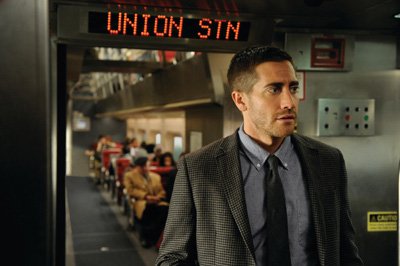 Producer Mark Gordon, whose credits include 2012 and Saving Private Ryan, was approached by screenwriter Ben Ripley with an idea about a man who discovers a way to travel back in time for short periods. "Ben Ripley came to us with a terrific idea for a film," says Mark Gordon. "Over a period of about six months to a year, we continued to develop the script with him. What you hope for in a collaborator is someone who has very strong opinions but at the same time will listen and consider another way of approaching it, and that's Ben Ripley. He has strong opinions and he sticks to his guns."
Producer Mark Gordon, whose credits include 2012 and Saving Private Ryan, was approached by screenwriter Ben Ripley with an idea about a man who discovers a way to travel back in time for short periods. "Ben Ripley came to us with a terrific idea for a film," says Mark Gordon. "Over a period of about six months to a year, we continued to develop the script with him. What you hope for in a collaborator is someone who has very strong opinions but at the same time will listen and consider another way of approaching it, and that's Ben Ripley. He has strong opinions and he sticks to his guns." As the script evolved, it attracted the attention of Philippe Rousselet, CEO of Vendôme Pictures and a producer of Source Code. "We loved the script," says Philippe Rousselet. "It's rare to find a unique story that is commercial at the same time. It's an intelligent and sophisticated thriller, and yet it's very entertaining. Things are revealed to the audience as they are revealed to the characters, which makes it a fun ride. It's not every day we have a chance to read a script like that."
Ben Ripley's idea was a nonlinear story with a science-fiction twist. "I'm fascinated by movies that tell a story in a nontraditional way," he says. "It occurred to me that the first experiments in time travel wouldn't be massively ambitious. We wouldn't go back hundreds of years; we'd go back minutes or hours. You can imagine this technology emerging almost by accident in a research laboratory somewhere and then being taken over by the Department of Defense. They don't really know what to do with it. It's still experimental. The fact that he has only eight minutes to complete his mission lends urgency to it because there is a limit on the information he was able to collect."
The screenwriter is willing to entertain the possibility that time travel will be possible someday. "Most of the time travel scientists like to talk about is future time travel," he says. "We may be able to slow down your clock when you're traveling close to the speed of light, which would allow you to move into the future. Time travel into the past is much more problematic and we don't really know how that would work. The past is unchangeable according to physics. What it does propose is the idea of a parallel universe, a copy of reality that's identical to ours. Source code is the ability to access another reality for an eight-minute period of time."
After developing the script with Ben Ripley, Mark Gordon sent it to actor Jake Gyllenhaal, who signed on to play Captain Colter Stevens. "Jake Gyllenhaal and I did The Day After Tomorrow together," says Mark Gordon. "We stayed in touch and were looking for another picture we could do together. He was very excited about this script and had a lot of valuable insights. Jake Gyllenhaal was a very important part of this movie coming together."
Almost all of the film's action takes place on a train headed for Chicago filled with commuters who make this trip this daily. But for one of those commuters, this is anything but an ordinary day. Colter Stevens, a Blackhawk helicopter pilot in the US Army, is there on an astonishing assignment. "He finds himself on a train one morning not knowing where he is or how he got there," says Jake Gyllenhaal. "Sitting across from him is a woman, Christina, who acts as if she knows him. He's pretty disoriented. Then in the reflection of a window he sees his face-only it's not his face."
In a matter of minutes, Colter soon discovers that he has been transported to the train from a few hours in the future. "Even to the characters in this movie, the source code technology is not entirely known," says Ben Ripley. "What happens to the Source Code world when we leave it? We don't know. Did it ever exist before we accessed it, or did we create it? We don't know."
Jake Gyllenhaal, who also starred in the time-travel cult classic, Donnie Darko, was intrigued by the premise, as well as the acting challenges inherent in his character's predicament. "I'm fascinated by the concept of time, so I loved mining that stuff," says the actor. "There was a lot for me to take in, especially in pre-production, in order to understand Colter. His overall arc keeps coming back to the eight minutes that he lives over and over again."
After signing on as leading man, Jake Gyllenhaal suggested to the producers that they approach director Duncan Jones, whose first film, Moon, made a big impression on the actor. "Moon was stunning from the first frame to the last," he says. "As I watched, it became so clear that Duncan Jones is fluent in the language of film. His storytelling is so agile that I immediately wanted to work with him."
Mark Gordon screened Moon and met with Duncan Jones on Jake Gyllenhaal's recommendation. "He was able to use one space and one actor so beautifully in Moon," says Mark Gordon. "Even though a great deal of our film takes place on a train car or two, it doesn't feel claustrophobic. It really feels like there's a lot going on."
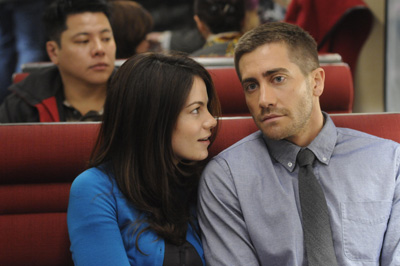 Duncan Jones' ability to create an original and wholly believable world for Moon was an important factor in his selection, says Philippe Rousselet. "Duncan Jones brought his unique visual world to the project. He's a great filmmaker and a very strong storyteller, which is exactly what Source Code needed. Duncan Jones is as passionate about the visual as he is about the actors and the storytelling, He's a complete filmmaker in that sense."
Duncan Jones' ability to create an original and wholly believable world for Moon was an important factor in his selection, says Philippe Rousselet. "Duncan Jones brought his unique visual world to the project. He's a great filmmaker and a very strong storyteller, which is exactly what Source Code needed. Duncan Jones is as passionate about the visual as he is about the actors and the storytelling, He's a complete filmmaker in that sense." There are some clear parallels to Source Code's explorations of time, identity and humanity in Duncan Jones' first film. "Duncan Jones seems to be interested in altering reality a bit," says Jake Gyllenhaal. "At at the same time, he gets to the heart of what's in the unconscious. In both these films, somebody is very lost at first and they have to find their way through this unfamiliar situation. They are trying to discover what they're doing and why they are there."
Despite the accolades and attention showered on him for his earlier work, Duncan Jones was not initially eager to make another science fiction film. "But I loved the script. It was tightly written and fast moving. I'm also a huge fan of Jake Gyllenhaal. I didn't want to pass up an opportunity to work with him."
Once the director came onboard, he and Jake Gyllenhaal began to hash out their ideas for the movie. Each had strong ideas about where the script was headed. "We developed an amazingly collaborative relationship," says Duncan Jones. "We added a lot more tongue-in-cheek humor than was originally on the page and I'm pleased with that. The love story became stronger and more touching, more so than I even realised when we were shooting it."
As tempting as it was for Duncan Jones to delve into the extensive scientific data available, he chose to concentrate on the narrative. "If I had allowed myself to get too bogged down in that side of it, it would've hindered the storytelling," he says. "I have a reasonable background in philosophy and science, so it was fairly easy for me to wrap my head around what was being suggested. I understood what the rules were and how the story had to be told within those rules, but I didn't allow myself to get stuck there."
He concentrated instead on unraveling the story's narrative as it evolved over the course of each source code. "The puzzle solving aspect of it was quite intriguing," says Duncan Jones. "For example, the number of locations is very limited and they are all enclosed in one way or another. How do you make characters out of each of them so that when we return to them, they actually can sense the changes, even though they may be quite subtle? Part of the challenge was to come up with that evolution. A lot of things became clear as filming progressed.
"The beauty of the script is that there's constantly new exploration," adds Duncan Jones. "Colter enters each repetition, or 'source code,' as we call them in the film, with more knowledge. Each time he brings something new to the situation. The challenge for us was how do you keep each source code fresh and give the audience something that's going to keep them engaged." Source Code is a prime example of a new wave of science fiction storytelling, according to the director.
"The mixture of humor and science fiction elements makes it something different and quite appealing. The audience doesn't need to get bogged down in the logic or the science of it all. They can just go along for the ride."
But for audiences who enjoy unraveling puzzles, the film offers plenty to ponder. "If half the audience comes away satisfied with the love story and the action, and the other half is intrigued by the ending and enjoys trying to work it all out, then I'll be very satisfied," says Duncan Jones. "I think there's enough there to keep everyone engaged."
According to Mark Gordon, there's another element for the audience to enjoy. "What's special about the film is that it has an enormous amount of action and it's a wonderful thriller," says the producer. "It's all things you hope for in a movie in terms of pure entertainment. But at the end of the film when the curtain comes down, so to speak, I'd like for people to walk out of the theater having enjoyed the thrills, but also thinking about how precious life is. Whether it's eight minutes or a lifetime, it is something that you should savor. We all have bad days, but life is magnificent and beautiful. It may sound a little hokey, but I think that when you leave the film, you have a greater sense of appreciation because Jake Gyllenhaal's character gets a second chance at life."
Casting Source Code
Each of Source Code's small group of characters plays an essential role in the drama that unfolds and each of the actors portraying them had to be able to deliver finely tuned performances under unusual and often challenging circumstances. "We felt very strongly that we had hired the right director," says Mark Gordon. "Then casting was an incredibly important part of the process. As a producer, if you get the script right, you hire the director that's right for the movie and you cast the right actors, you're 80 percent there. Then you just let people do what they do."
Duncan Jones is grateful to have been able to work with actors of the caliber of those in Source Code. "I have been phenomenally lucky as a director in getting the casts I have," says Duncan Jones. "On this film, I got Jake Gyllenhaal, Michelle Monaghan, Vera Farmiga and Jeffrey Wright-all of them tremendous actors. To be able to bring them all together in one film was fantastic." At the heart of the ensemble is Jake Gyllenhaal, playing Captain Colter Stevens. "Jake Gyllenhaal has a very special rapport with the film," Philippe Rousselet says. "He's been a fantastic asset. He's very passionate, hard working, and full of smart, creative ideas. I keep telling him he should direct a film, because he's a very talented guy, and not just as an actor. He likes to be creative on set and try different things. He was definitely a driving force in the process of making this movie."
Captain Colter Stevens is certainly an action hero, but the complexities of the story required more than a chiseled physique, a square jaw and a steely gaze. "There was a lot of brainwork in the movie," says Jake Gyllenhaal. "But once we got to the set, I had to be able let go of the cerebral part so we could tell the story of a guy lost in time. Emotions are hitting him from all sides, which is great fun for an actor."
The first day of shooting was crucial for everyone in the cast, says Jake Gyllenhaal, because the things they did that day would be repeated, with variations, in scenes that followed. "As soon as we set the action in motion for the first source code-the first time on the train-every subsequent scene had to match. Then I came in and changed the scenario a little bit each time to try and get a different outcome. We sometimes had to stop and take an hour or so to make sure we had things right."
The filmmakers had a long list of requirements for the actress who would play Christina, Colter's love interest. She becomes Colter's touchstone each time he returns to the train. "We wanted to make sure in the storytelling that there was someone that Jake Gyllenhaal's character could connect to on that train," says Mark Gordon. "That made the situation personal for him. He wants to do more than just save these strangers. We were looking for someone who was funny and charming and sassy, someone who could make an impression without a lot of screen time, because she would be reliving the same eight minutes over and over again. Michelle Monaghan is wonderfully warm actress, very vulnerable and very kind. And that was critical for that role."
Duncan Jones had seen Michelle Monaghan in Kiss Kiss Bang Bang and thought she fit the bill. "Our first meeting was over Skype," he says. "We got on very well. She has such a great, enthusiastic personality. I came away from that conversation extremely excited about Michelle Monaghan."
For Michelle Monaghan, the combination of script, director and star were irresistible. "I was intrigued with the challenge of playing the same day over and over again," says Michelle Monaghan. "It was all about finding the nuances. A challenge like that forces you to be as creative as you can because you're shooting essentially the same dialogue, but trying to bring something fresh to it. "Duncan Jones has extraordinary vision," continues Michelle Monaghan, "which made the prospect of working with him exciting. And then on top of that, I got to work with Jake Gyllenhaal, who is a terrific guy and a terrific actor. He's probably one of the most supportive actors I've ever worked with."
Once on set, the chemistry was immediate, says Duncan Jones. "She and Jake Gyllenhaal are unbelievable together. Michelle Monaghan wasn't scared of trying different things, which was wonderful, because Jake Gyllenhaal really wants to do that and is good at it. When they were working together, we would do a couple of takes straight down the line of the script. Then they would start playing around with it and trying to be a little bit more improvisational.
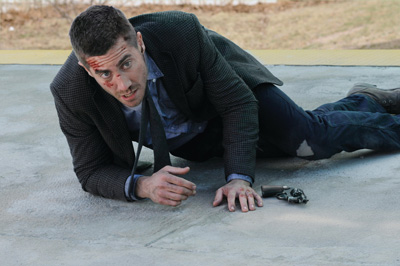 "Jake Gyllenhaal would throw things at her, but he never put her off," the director continues. "It created a sort of butterfly effect. Jake Gyllenhaal would react off the smallest change, and that would give Michelle Monaghan the opportunity to subtly change her performance for the next bit. It was a back-andforth game that the two of them had."
"Jake Gyllenhaal would throw things at her, but he never put her off," the director continues. "It created a sort of butterfly effect. Jake Gyllenhaal would react off the smallest change, and that would give Michelle Monaghan the opportunity to subtly change her performance for the next bit. It was a back-andforth game that the two of them had." Duncan Jones' work style combines extensive advance preparation with an easy-going attitude on set, says the actress. "Duncan Jones seems to have no ego whatsoever. If he likes something, he'll let you know, and if he doesn't, he'll have you do it another way. There's a lot of comfort in knowing that you can trust him.
"He storyboards all of his scenes," Michelle Monaghan adds. "The actors and crew always knew the effects he was aiming for. Still, he was open to allowing us to do a lot of different variations on the scenes. He's inspiring in that way."
Vera Farmiga came to the film fresh off a 2010 Academy Award® nomination for Best Supporting Actress in Up in the Air. Her character, Colleen Goodwin, is a captain in the Air Force and the designated source code coach for Colter. "She's the human behind the voice of Oz, guiding him back and forth between these two realities," she explains.
The actress was Duncan Jones' only choice for the role. "I don't think we even thought about anyone else," he says. "I had just seen Up in the Air when we started talking about casting that part. I had seen her in other films, but I suddenly saw a whole different side to her. She is incredibly talented, incredibly kind and very easy to communicate with.
"One of the beauties of working with Vera Farmiga is there's so much going on in her face," he adds. "She's able to communicate with the subtlest movements or gestures. She uses that ability to great effect in our film. There isn't a huge amount of flexibility because all of her scenes take place in the same small environment. That was complicated further by the fact that Jake Gyllenhaal's character is not in the same room with her when they speak. It's tricky for an actor to have a conversation with someone who isn't actually there."
Vera Farmiga draws a parallel between that way of working and Internet dating, another situation in which people try to form a personal connection without physical presence. "By nature of there being these two separate realities that our characters function in, we were very seldom in the same space," she says. "I worked primarily with Jake Gyllenhaal's voice, although, out of the kindness of his heart, he did his lines just off-camera on several days. But, in reality, my character is not interacting with someone who is present in the same room with her."
Her limited time working with Jake Gyllenhaal created a bond that remained even after he left the set. "Working with Jake Gyllenhaal was effortless," she says. "He's easygoing, he has an incredible sense of humor, and he's a good sport. He has a warmth and a humor and a relaxation about the process, and a confidence that you just draw upon. It's just a pleasure to be around him and to invent with him."
Like her co-stars, Vera Farmiga was familiar with Moon and looking forward to working with Duncan Jones. "I could tell he was a deep thinker and a philosopher by nature by watching his earlier work," says Vera Farmiga. "I think Duncan Jones has some experience negotiating through what's real and what's not in his own life. He brings a unique voice and style to filmmaking, exploring his characters' psyches to tell a story. It's all about nuance. His work adds warmth to a genre that can be technical and plot-driven."
The audience experience of Source Code will, she thinks, be both entertaining and thought-provoking. "I hope they walk away winded and exhilarated from the joy ride, and I hope they look at themselves, their own realities and assess them in a different way. Good films are a reminder to look into yourself."
Colleen Goodwin's supervisor is the somewhat mysterious Dr. Walter Rutledge, played by Jeffrey Wright. The filmmakers wanted someone for Dr. Walter Rutledge who could walk that fine line between hero and villain and take both sides of a political argument and leave you not knowing whether he's right or wrong and they found that in Jeffrey Wright.
That paradox led to some serious discussion between actor and director on just who Dr. Walter Rutledge is, says Duncan Jones. "Is he a good guy? Is he a bad guy? We tried playing it in different ways to discover who he actually is. Dr. Walter Rutledge has a very understandable reason for being the way he is. Whatever he does, no matter how nefarious it may appear, his argument has justification at the end of it. He wants to save as many lives as he can. It's just unfortunate for this poor sap Colter Stevens that the brunt of the unfairness lands on him."
Jeffrey Wright was taken with the idea of what he calls "a jagged sci-fi thriller, with elements that ground it in the contemporary." The script's multi-layered approach keeps it exciting and always a couple steps ahead of the audience. "It has the trappings of a big-budget action-adventure picture," he says. "At the same time, it got me thinking about current realities in a way that added to the thrills. Not every film has to have a message, but I try to find projects that have some kind of relevance, even when they have escapist elements as well."
Jeffrey Wright's research grounded his character in real world scientists, and in the process he learned more than he expected about the technical side of the story. "The Internet is an incredible research tool for an actor," he says. "Going online and reading and YouTubing some folks, I got to learn about some of the latest developments in quantum mechanics. Hearing the passion with which some of these scientists describe their work revealed some interesting character traits that I tried to draw from."
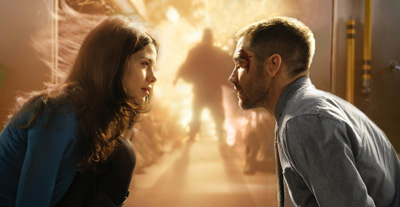 Jeffrey Wright says he came to believe that the technologies touched on in the film may not be as farfetched as they at first seemed. "We don't know what's going on out there. It's a thrilling journey that will have the audience thinking and feeling." Feeling, he says, because at the core of the movie is a subtle homage to the men and women who are standing in harm's way now on behalf of others. "I think there's an underlying theme about duty and sacrifice, about honor, that won't be missed by the audience."
Jeffrey Wright says he came to believe that the technologies touched on in the film may not be as farfetched as they at first seemed. "We don't know what's going on out there. It's a thrilling journey that will have the audience thinking and feeling." Feeling, he says, because at the core of the movie is a subtle homage to the men and women who are standing in harm's way now on behalf of others. "I think there's an underlying theme about duty and sacrifice, about honor, that won't be missed by the audience." In the latter part of the development process, the filmmakers added a character named Max Denoff, to typify the angry train commuter. As the character became more fleshed out, he evolved into a standup comedian with a limited amount of fame and unlimited ego. They found local Canadian comedian Russell Peters.
The character of Max Denoff attained his notoriety by coming in third on the reality show "America's Got Talent. "He's also got two DUIs and a serious attitude problem," says Russell Peters, a stalwart on the comedy circuit. "In Max Denoff's mind, he's the most famous person in the world. I created him from characters that I know from doing stand up for 21 years. He's the comic relief on this movie."
To Duncan Jones' regret, some of Russell Peters' funniest onset antics were left on the cutting room floor. "We had to keep the rating of the film in mind," the director says. "There was so much funny stuff he was doing, but a lot of it was a little blue. I knew he was a great comedian, but my concern overall was the acting side. It was a pleasant surprise to see how good he actually is."
Max Denoff is Russell Peters' most visible acting role to date and being on set left him a bit starstruck early on. "I was very intimidated the first couple of days," he admits. "Every time one of the stars walked by me, I thought, 'That's Jake Gyllenhaal. Oh, my God. That's Michelle Monaghan.' They're both very focused actors who roll with the punches. I was very impressed with them, A) for being great actors, and B) for being so versatile."
At the end of the day, he says, this film is as much a love story as an action movie. "The guy is trying to save all these people on the train," says Russell Peters. "But he falls in love with the girl that he rides the train with every day. I look at it and think, what would I do in that situation? Would I try to save all these people?"
All Aboard
Inventive visuals and imaginative realisations of technology that doesn't yet exist are becoming a trademark for filmmaker Duncan Jones. He credits his early work directing commercials for honing his ability to tell stories effectively through pictures. That experience, he says, has given him a greater appreciation of the aesthetics of each shot.
For Source Code, Duncan Jones worked with a stellar team to realise his ambitious visuals, including director of photography Don Burgess, who also served as cinematographer for Forrest Gump, Spiderman and Castaway, among many other well-regarded films. "Our experiences have been completely different," says Duncan Jones. "He has masses of experience in film, whereas I have a limited amount. What I do have from working in commercials is the understanding that there are requirements above and beyond your own creative vision for things. But I think we both found ourselves surprised by the challenges involved in this film's limited settings."
Duncan Jones worked closely with production designer Barry Chusid to create the various sets. "Barry Chusid and I talked for a long time about how to get the most out of our designs," says Ducan Jones. "We needed three separate, specially designed environments: the train environment, the pod and the laboratory where Colleen Goodwin and Dr. Walter Rutledge are based."
Barry Chusid has successfully brought film worlds to reality that range from a Revolutionary War-era farm (The Patriot) to an apocalyptic near future (2012) and a fantasy underworld of vampires and their slayers (Blade). He says he approaches all of his creations, however exotic or unfamiliar, from a practical point of view.
In this case, he started with a simple fact: they needed a train. "Well, what exactly is the train?" he asks. "Is it a modern train? A period train? European trains look too modern, but some of the older trains that are in use in America look too old. We didn't want it to seem like he was traveling to the future or to the past."
Their first decision was whether to use an existing train, or to build one from scratch. But the filmmakers quickly decided that they would have to contain the environment on a stage to maintain the continuity of what both the passengers and audience could see outside the train windows.
The inspiration for the train they built came from a very realistic proposition. "We came up with the idea that the Metro train in Chicago got TARP money," Barry Chusid says. "If they got X amount of hundreds of thousands of dollars per car, what would they do? That was our jumpingoff point. It would honor the Metro train in Chicago, but it would be our version of it."
The train car was constructed to be easily disassembled, to facilitate camera placement and allow virtually unlimited movement. "It is like a Lego," says Barry Chusid. "It comes apart in a million different pieces so you can shoot from every angle. All the heights and the widths and the proportions were adjusted to make them appropriate for our purposes."
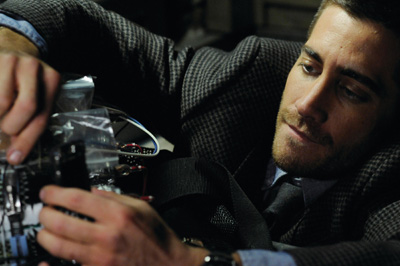 The car became one of the primary settings for the film, standing in for different parts of the train throughout the shoot. "It was a beautiful thing," says Duncan Jones. "And it was a bit of a monster. While it made much more sense to build something this versatile, the set imposed its style on us. But we went with it, and eventually it became very organic and natural to work with." The train was assembled atop a large gimbal, a device that allowed the filmmaker replicate the movement of train along the tracks. Every time the train moved, the exterior had to be carefully matched to the angle from which the scene was shot.
The car became one of the primary settings for the film, standing in for different parts of the train throughout the shoot. "It was a beautiful thing," says Duncan Jones. "And it was a bit of a monster. While it made much more sense to build something this versatile, the set imposed its style on us. But we went with it, and eventually it became very organic and natural to work with." The train was assembled atop a large gimbal, a device that allowed the filmmaker replicate the movement of train along the tracks. Every time the train moved, the exterior had to be carefully matched to the angle from which the scene was shot. "Everything that you see outside of the windows is green screen," says Duncan Jones. "Our visual effects supervisor Louie Morin went to Chicago and shot all the footage. We needed to be able to fill in the green screens no matter what angle our camera was shooting. There was an awful lot of working out what we were going to do in advance to make sure that what he shot out the windows would match the environment on the train."
The lab environment where Colleen Goodwin and Dr. Walter Rutledge are based is a prime example of the way Duncan Jones and his team used images to tell the story in the film. "Everything in the lab set was designed to support the narrative," says Barry Chusid. "We brainstormed ideas for telling the story of the source code program visually within that environment. There are clues everywhere you look. Colleen Goodwin spends all of her time sitting in one spot. If you were able to scan all 360 degrees of the room from Colleen Goodwin's point of view, you would see the story of what's been happening to Colter. Over the course of the movie, we reveal it little by little, as the pieces of the puzzle start to come together."
The pod that enables Colter to cross time and space gave the filmmakers the most creative freedom. "It's very minimally described in the script, so we had a great deal of leeway as far as what we could do with it," says Duncan Jones. "It's a strange environment and it's probably the one where we had the most opportunity for artistic interpretation.
"One of my fears when I was reading the script is how do we keep this interesting?" he says. "You can't have a guy in a box the whole time. We came up with a space like a helicopter cockpit. The difference is that it changes subtly over the course of the film to reflect Colter's emotional states."
In the end of, all of the decisions Duncan Jones and Barry Chusid made for the film were based in the emotional and physical reality of the Source Code story. "Duncan Jones and I didn't spend a lot of time talking about the science fiction part of the movie," Barry Chusid says. "We are both very pragmatic guys, so we just thought about the practical issues."
And by doing that, says Duncan ColJones, they were able to keep the film's technological inventions in the realm of the possible, allowing the human story to remain front and center. "The story ultimately is about relationships and about how people bond. That's where I wanted to keep the focus. And as long as it flows, as long as there's continuity and logic, that will be what the audience is left with. It's about Colter and Christina, and Colter and Colleen Goodwin. All the rest of it is important in relation to that."
MORE





